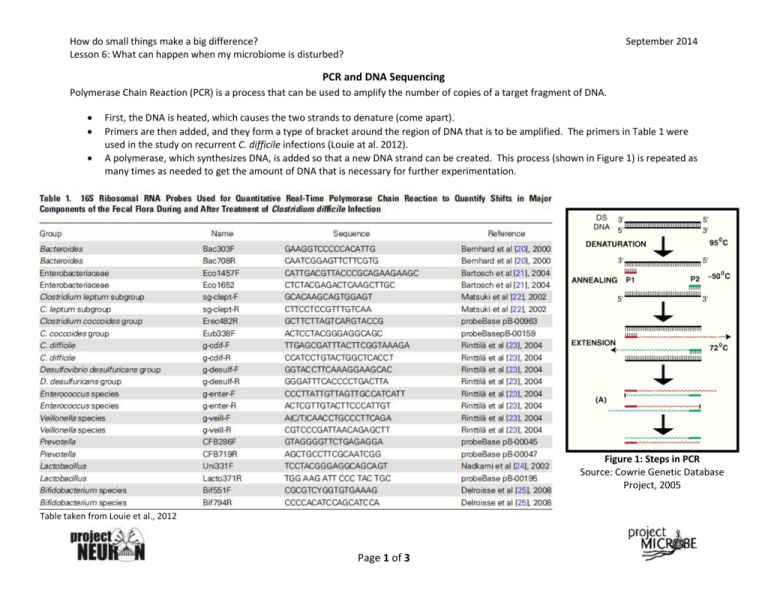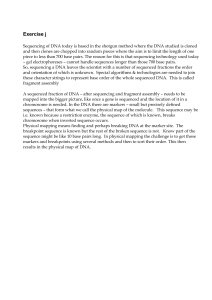Resource: PCR
advertisement

How do small things make a big difference? Lesson 6: What can happen when my microbiome is disturbed? September 2014 PCR and DNA Sequencing Polymerase Chain Reaction (PCR) is a process that can be used to amplify the number of copies of a target fragment of DNA. First, the DNA is heated, which causes the two strands to denature (come apart). Primers are then added, and they form a type of bracket around the region of DNA that is to be amplified. The primers in Table 1 were used in the study on recurrent C. difficile infections (Louie at al. 2012). A polymerase, which synthesizes DNA, is added so that a new DNA strand can be created. This process (shown in Figure 1) is repeated as many times as needed to get the amount of DNA that is necessary for further experimentation. Figure 1: Steps in PCR Source: Cowrie Genetic Database Project, 2005 Table taken from Louie et al., 2012 Page 1 of 3 How do small things make a big difference? Lesson 6: What can happen when my microbiome is disturbed? September 2014 One method of sequencing a strand of DNA is called “Dye-Terminator Sequencing” (Figure 2). Dye-Terminator Sequencing allows scientists to sequence DNA much quicker. This benefit of Dye-Terminator Sequencing is one reason why it is a preferred method by today’s scientists. First, modified versions of nucleotides are used to separate the DNA that was amplified during PCR into four distinct groups based on their nucleotide base. Then, each chain terminator nucleotide is labeled with a different fluorescent dye. Each of these dyes will fluoresce at a different wavelength, allowing the reactions to be distinguished from one another. Scientists are then able to sequence the DNA by recognizing whether an A, T, G, or C is present based on the color of the fluorescent reaction (Figure 3). Figure 2: Steps of dye-terminator sequencing Source: Kotrla, 2007 Figure 3: Fluorescent peaks detected by a sequencing machine Source: Lakdawalla, 2007 Page 2 of 3 How do small things make a big difference? Lesson 6: What can happen when my microbiome is disturbed? September 2014 References: Cowrie Genetic Database Project. (2005). DNA amplification. Florida Museum of Natural History. Retrieved from: http://www.flmnh.ufl.edu/cowries/amplify.html Kotrla, T. (2007). Sequencing Procedure. Retrieved from: http://www.austincc.edu/mlt/mdfund/mdfund_unit12objectives.html Lakdawalla, A. (2007). Radioactive Fluorescent Seq. Wikipedia. Retrieved from: http://en.wikipedia.org/wiki/DNA_sequencing Louie T.J., Cannon K., Byrne B., Emery J., Ward L., Eyben M., Krulicki W. (2012) Fidaxomicin preserves the intestinal microbiome during and after treatment of Clostridium difficile infection (CDI) and reduces both toxin reexpression and recurrence of CDI. Clin Infect Dis. 55 Suppl 2:S132-42. Obenrader, S.The sanger method.Davidson College. Retrieved from: http://www.bio.davidson.edu/Courses/Molbio/MolStudents/spring2003/Obenrader/sanger_method_page.htm Page 3 of 3







